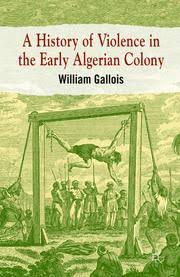William Gallois. 2013. A History of Violence in the Early Algerian Colony. Basingstoke:
Palgrave Macmillan. 207 pp.
In recent years the Algerian nineteenth century has benefitted from an abundance of new
studies, as authors seek to build upon standard accounts of the conquest and its aftermath.
Many of these examine the violence inherent in the colonization process, presenting the early
imperial experience as coercive and disruptive, engendering physical assault, hegemonic social,
political, and economic institutions, or the manipulation of environmental, cultural, and
architectural norms and practices. The latest entry into the field is Willaim Gallois’s A History of
Violence in the Early Algerian Colony, a book that provides a long overdue reassessment of the
1830-48 wars of conquest in Algeria, based upon archival material from the Service historique
de la défense and a variety of published first-hand accounts, including memoirs, diaries, and
letters.
For Gallois, violence was not simply the collateral damage of a colonial military campaign.
Rather, the French unleashed a barrage of massacres and destruction that decimated entire
tribal communities, inflicting thousands of casualties while sustaining virtually no damage
themselves. Its purpose was not to defeat the enemy, but to communicate the necessity of
complete submission to French authority. Thus to Gallois, violence in Algeria formed an
integral component of the French colonial mind from the very beginning, rather than appearing
only under settler rule or during the 1954-62 Algerian War. Of course, this strategy was based
upon the assumption that Arabs and Kabyles were savages, unable to comprehend anything
but brutality. In this regard, Gallois interestingly notes the influence of a series of works
purporting to describe Barbary pirates who combined Islamic zealotry with the torture and
murder of Europeans, which informed the views of French soldiers, ministers, and public alike.
Although the truth was far less lurid—shipwrecked sailors mostly received food and shelter
and not agonizing death or forced conversion—Prime Minister/Minister of War Nicolas Jeande-Dieu
Soult and the High Command ordered that any soldier’s death would be avenged
against the public at large, leading to the destruction of entire villages. Rumours of jihad,
ambushes, and mutilation fed French military frenzy, evolving into a push for total domination.
As Gallois adroitly observes, the more sedate Algerian reality threatened to foil plans to use
violent means to implement highly profitable colonial trade, a settler society, and military
government. Hence Governor General/military commander Thomas Bugeaud resorted to
exaggeration, portraying rebel leader Abd-el-Kader as a dangerous opponent, a fabrication used
alongside the threat of Moroccan or British intervention to justify the human and material costs
of occupation. This set the stage for a battle between “legalist” proponents of the mission
civilisatrice who desired a military campaign in keeping with Gallic laws and “civilization,” and
Bugeaud’s concept of total war, which in practice meant official tolerance of rape, murder, and
massacres. Any tribe that refused to obey French directives faced the razzia, typically seen by
historians to involve physical mass murder, but broadened by Gallois via a highly original
typology of violence in French Algeria. In addition to mass killings, there were assaults on
resources (principally food seizures, which simultaneously starved the conquered while feeding
undersupplied French troops), lifeworld/environmental cases (the eradication of tribes through
the elimination of their habitat, including the burning of crops), and finally exterminatory
forays in which soldiers were permitted to kill at will.
